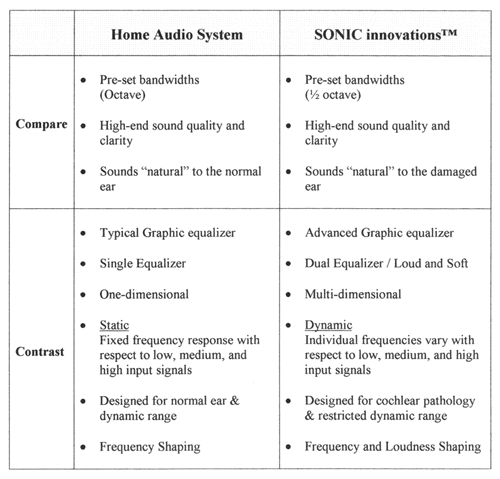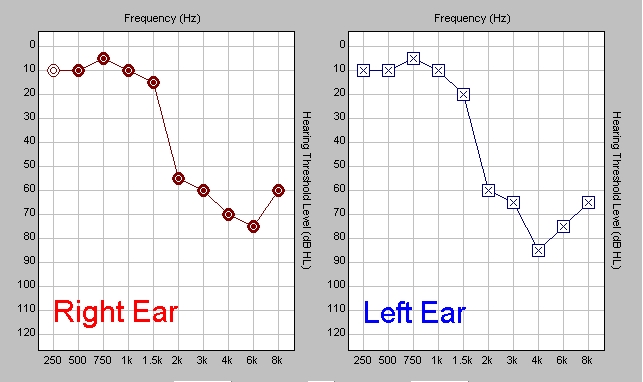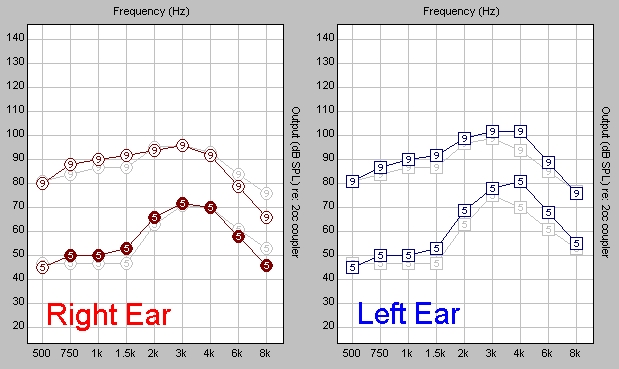Merritt Johns, M.S., Manager of Marketing Communications
Victor Bray, Ph.D., Vice-President for Auditory Research
SONIC innovations
2795 East Cottonwood Parkway, Suite 660
Salt Lake City, Utah 84121-7036
Introduction
As a consumer you desire the best sound quality a stereo system offers. With a graphic equalizer as part of your audio system, the desire to tailor the sound to your ear and environment becomes a reality. The system's ability to frequency-shape the response to compensate for environmental differences allows the reproduction of music the way you desire to hear it. The end result is a finer appreciation of the multiple dimensions of music such as unmuddled lyrics and melody, instrumental timbre, and a sense of 'space' around the performance.
Your patients also desire this superior sound quality, not only for music, but also for speech. In the past, the primary obstacles to providing such sound quality from a hearing instrument were the inability to effectively frequency-shape the gain response and to independently 'loudness-shape' the output response for the abnormal loudness growth of the damaged cochlear amplifier.
The NATURA™, ALTAIR™, and CONFORMA™ digital hearing aids from SONIC innovations overcome these obstacles by providing a graphic equalizer interface that goes beyond the basic utility of graphic equalizers found in home audio systems.
The Typical Graphic Equalizer
As hearing care professionals we strive to educate our patients in the areas of hearing loss and rehabilitation. We encourage the patient to purchase more sophisticated hearing instruments with the objective of increasing patient satisfaction. We often explain a patient's hearing and hearing loss in terms of a graphic equalizer on a stereo system. Since the cochlea processes sounds across multiple, frequency-specific narrow bands and the typical graphic equalizer similarly provides independent frequency-shaping in octave intervals, one can easily establish a comparison. Using this analogy of a graphic equalizer, the patient's hearing loss represents an attenuator to the graphic equalizer. Therefore, a hearing instrument represents an enhancer to the graphic equalizer, specifically when it adjusts individual frequency bands across the same frequencies tested during the patient's evaluation.
The home audio system, through the use of the graphic equalizer, shapes or 'equalizes' the frequency response when a room's acoustics interfere with the sound system's ability to deliver the desired range of frequencies to the ear. Due to the acoustic limitations of a particular room, the graphic equalizer might be used to attenuate the low-frequency response and enhance the mid- and high-frequency response in order to produce the targeted sound quality.
The graphic equalizer used in home audio is a one-dimensional system. The dimension it alters is the frequency response. Once shaped, the frequency response is fixed, or static, and the system applies the same frequency shaping to low, medium, and high sound levels. However, the ability to create a fixed, or static, frequency shape is not sufficient for providing superior sound quality to hearing-impaired individuals. For superior sound quality in hearing aid applications, frequency-shaping must be multi-dimensional; allowing individual frequency bands to be shaped based on the input level of the signal. Only multi-channel, frequency-specific, level-dependent compression meets these multi-dimensional requirements. Therefore, the graphic equalizer typical of home audio systems cannot provide the superior sound quality desired by the hearing impaired individual.
The Advanced Graphic Equalizer
It is now well known that damage to the hair cells in the cochlea produces frequency-specific sensorineural hearing loss (loss of sensitivity) and frequency-specific loudness recruitment (reduction in dynamic range). The recruitment problem associated with cochlear damage is characterized by little or no sensitivity to low-intensity signals, mild loss of sensitivity to mid-intensity signals, and normal sensitivity to high-intensity signals. The rate of loudness growth is usually different at every frequency involved in the hearing loss. Any hearing instrument using a one-dimensional graphic equalizer approach provides some frequency-shaping for the loss of sensitivity, but cannot compensate for the recruitment problem. Only a multi-dimensional hearing aid, using an advanced graphic equalizer, provides individual frequency-shaping that is level-dependent.
A multi-dimensional graphic equalizer, which operates as a bank of multiple, narrow-band compression amplifiers supplies altered sound to the impaired ear using frequency-shaping for gain and loudness-shaping for output. When the hearing instrument automatically adjusts the output of individual frequency components based on their input levels, and applies more gain to low-intensity sounds than to high-intensity sounds, it becomes possible to implement a hearing aid design that models the cochlear amplifier. Table 1, below, compares and contrasts the typical graphic equalizer with the advanced graphic equalizer used in the NATURA, ALTAIR and CONFORMA hearing aids.

Table 1: Compare and contrast between the home audio system (typical graphic equalizer) with Sonic Innovations digital hearing aids (advanced graphic equalizer).
The digital hearing aids from SONIC innovations have nine parallel, independent, narrowband compressors operating at half-octave intervals centered on the audiometric testing frequencies (500 Hz, 750 Hz, 1 kHz, 1.5 kHz, 2 kHz, 3 kHz, 4 kHz, 6 kHz, and 8 kHz) (Bray et al, 1998). Unique to the design is an advanced graphic equalizer allowing independent frequency-shaping for both soft and loud sounds. The fitting system, EXPRESSfit™, displays this advanced frequency shaping as a dual, half-octave graphic equalizer, represented by two output curves, referred to as the '5' curve, for soft input signals (50 dB SPL) and the '9' curve, for loud input signals (90 dB SPL) (Johnson et al, 1999).
These displayed curves also represent the 2-cm3 coupler response of the hearing aid at the recommended 50 and 90 dB SPL pure-tone signal test levels for compression hearing aids (ANSI S3.22-1996). The points on each curve represent the 'handles' at each frequency. Moving the handles up and down allows adjustment of gain and output at a specific center frequency, much like moving the sliders on a graphic equalizer. The handles on the '5' curve control the gain at individual frequencies for overcoming the loss of sensitivity associated with a patient's hearing loss. The handles on the '9' curve control output, limiting the acoustic energy delivered at individual frequencies to compensate for loudness recruitment. The interaction of moving the '5' and '9' handles closer to each other increases the compression ratio, whereas moving them farther apart decreases the compression ratio.
Case Study
The patient is a 58-year-old female who works as a computer programmer. She complains of difficulty in meetings and group settings. Her audiometric profile shows a bilateral, symmetric, sensorineural loss (see Figure 1). The subject was fit binaurally with new, NATURA ITE hearing aids to match the configuration of her previous, personal aids.

Figure 1: Case study audiogram showing precipitous high-frequency hearing loss, more pronounced in the left than right ear.
The audiogram shows a precipitous hearing loss. This hearing loss is difficult to amplify because of discomfort from amplification where hearing is normal, recruitment in the high frequencies where the loss is most severe, and occlusion problems. Figures 2a (right ear) and 2b (left ear) show the original predicted fitting and the actual final fitting after adjustments for needed gain, tolerated loudness, vocal quality, and feedback.

Figure 2a and 2b: Digital hearing aid fitting. Predicted settings are the shaded values. Final settings are the solid values.
Relative to the predicted fitting, the excess recruitment in the right ear (Figure 2a) was compensated for by reducing the high-frequency output. The volume of speech, as heard in the right ear, was reported to be slightly softer than in the other ear and the 1500 Hz value was raised to 'smooth' the transition between the region of normal hearing and hearing loss. The final curves for the left ear (Figure 2b) were increased to 'open up' the patient's perception of her own voice, which was slightly muffled compared to the right ear. The only other adjustment to the right ear was for feedback by reducing the high-frequency gain and output. With these new hearing aids the patient reported 'I notice I leave the hearing aids on longer and forget I am wearing them.'

Figure 3a and 3b: Hearing aid fitting compression ratios across the 9 compression channels. Predicted settings are the shaded values. Final settings are the solid values.
As stated previously, the interaction between the '5' and '9' handles establishes the compression ratio. In this case study (see Figure 3), the compression ratios transition from 1.0 toward 2.0 as the hearing transitions from normal at 1.5 kHz to a moderately-severe loss at 3 kHz. Also note that the compression ratios of the final fitting are slightly greater than the predicted settings. This is a result of increasing the gain ('5' handles) more than the output ('9' handles) during the fine-tuning process. The system automatically applies the appropriate frequency-specific compression ratio as a result of the patient's loss of sensitivity to soft sounds and loudness growth function for the individual audiometric frequencies. Thus it is the patient's dynamic range at each frequency that dictates the compression ratio.
Summary
In order to provide superior sound quality to hearing-impaired individuals, the hearing instrument must have a multi-dimensional graphic equalizer that allows individual frequency bands to be controlled based on the input of the signal. The equalizer must frequency-shape soft sounds to compensate for the loss of hearing sensitivity, and frequency-shape the loudness growth function to compensate for recruitment. SONIC innovations digital hearing aids provide this advanced graphic equalizer, allowing the hearing aid's output to be dynamic and consequently the sound quality to be 'natural' to the damaged ear.
Acknowledgements
The authors wish to acknowledge Michael Nilsson, Ph.D., for providing the case study information and valuable comments on this manuscript.
This article originally appeared on www.audiologyjournal.com. Audiology Online (www.audiologyonline.com) has acquired the Audiology Journal. This paper has been re-edited and updated and appears here as a courtesy to our readers for educational and informational purposes. We are grateful to the author and to Audiology Journal for allowing us (Audiology Online) to re-publish this updated version of this article here. ---Douglas L. Beck Au.D. Editor-In-Chief, Audiology Online.
References
- ANSI S3.22-1996. Specification of Hearing Aid Characteristics.
- Bray, Chabries, Davis & Johnson (1998). Digital Signal Processing (DSP) Derived from a Nonlinear Auditory Model. AAA Poster, Los Angeles.
- Johnson, Nilsson, Ghent & Bray (1999). Implementation of a Personal Digital Assistant as a Hearing Aid Fitting/Programming System. AAA Poster, Miami Beach.
For more information on Sonic Innovations click here.
Click here to visit the Sonic Innovations website.

